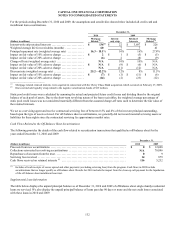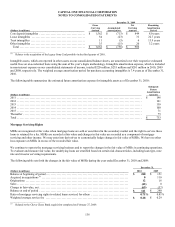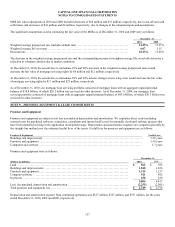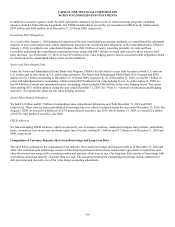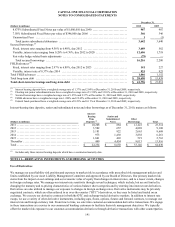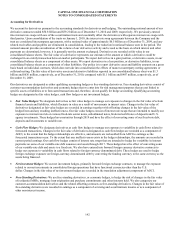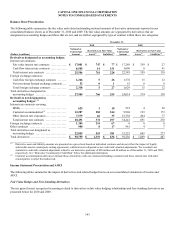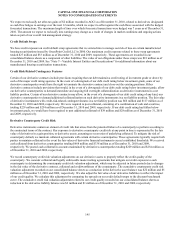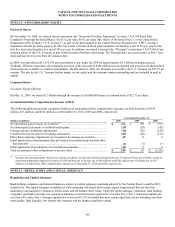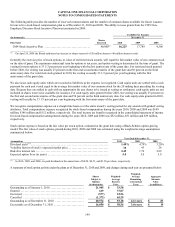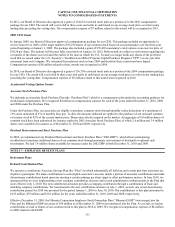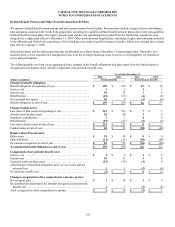Capital One 2010 Annual Report Download - page 162
Download and view the complete annual report
Please find page 162 of the 2010 Capital One annual report below. You can navigate through the pages in the report by either clicking on the pages listed below, or by using the keyword search tool below to find specific information within the annual report.CAPITAL ONE FINANCIAL CORPORATION
NOTES TO CONSOLIDATED STATEMENTS
142
Accounting for Derivatives
We account for derivatives pursuant to the accounting standards for derivatives and hedging. The outstanding notional amount of our
derivative contracts totaled $50.8 billion and $59.2 billion as of December 31, 2010 and 2009, respectively. We previously entered
into interest rate swaps with one of the securitization trusts and essentially offset the derivatives with separate interest rate swaps with
third parties. Upon consolidation of the trusts on January 1, 2010, the interest rate swap agreements between the Company and the
trust are considered intercompany agreements, with a notional value of approximately $6.5 billion as of December 31, 2009, and any
related receivables and payables are eliminated in consolidation, leading to the reduction in notional balance seen in the period. The
notional amount provides an indication of the volume of our derivatives activity and is used as the basis on which interest and other
payments are determined; however, it is generally not the amount exchanged. Derivatives are recorded at fair value in our
consolidated balance sheets. The fair value of a derivative represents our estimate of the amount at which a derivative could be
exchanged in an orderly transaction between market participants. We report derivatives in a gain position, or derivative assets, in our
consolidated balance sheets as a component of other assets. We report derivatives in a loss position, or derivative liabilities, in our
consolidated balance sheets as a component of other liabilities. Our policy is to report derivative asset and liability amounts on a gross
basis based on individual contracts, which does not take into consideration the effects of master counterparty netting agreements or
collateral netting. The fair value of derivative assets and derivative liabilities reported in our consolidated balance sheet was $1.3
billion and $636 million, respectively, as of December 31, 2010, compared with $1.1 billion and $407 million, respectively, as of
December 31, 2009.
Our derivatives are designated as either qualifying accounting hedges or free-standing derivatives. Free-standing derivatives consist of
customer-accommodation derivatives and economic hedges that we enter into for risk management purposes that are not linked to
specific assets or liabilities or to forecasted transactions and, therefore, do not qualify for hedge accounting. Qualifying accounting
hedges are designated as fair value hedges, cash flow hedges or net investment hedges.
• Fair Value Hedges: We designate derivatives as fair value hedges to manage our exposure to changes in the fair value of certain
financial assets and liabilities, which fluctuate in value as a result of movements in interest rates. Changes in the fair value of
derivatives designated as fair value hedges are recorded in earnings together with offsetting changes in the fair value of the
hedged item and any resulting ineffectiveness. Our fair value hedges consist of interest rate swaps that are intended to modify our
exposure to interest rate risk on various fixed-rate senior notes, subordinated notes, brokered certificates of deposits and U.S.
agency investments. These hedges have maturities through 2019 and have the effect of converting some of our fixed-rate debt,
deposits and investments to variable rate.
• Cash Flow Hedges: We designate derivatives as cash flow hedges to manage our exposure to variability in cash flows related to
forecasted transactions. Changes in the fair value of derivatives designated as cash flow hedges are recorded as a component of
AOCI, to the extent that the hedge relationships are effective, and amounts are reclassified from AOCI to earnings as the
forecasted transactions occur. To the extent that any ineffectiveness exists in the hedge relationships, the amounts are recorded in
current period earnings. Our cash flow hedges consist of interest rate swaps that are intended to hedge the variability in interest
payments on some of our variable-rate debt issuances and assets through 2017. These hedges have the effect of converting some
of our variable-rate debt and assets to a fixed rate. We also have entered into forward foreign currency derivative contracts to
hedge our exposure to variability in cash flows related to foreign-currency denominated debt. These hedges are used to hedge
foreign exchange exposure on foreign-currency denominated debt by converting the funding currency to the same currency as the
assets being financed.
• Net Investment Hedges: We use net investment hedges, primarily forward foreign exchange contracts, to manage the exposure
related to our net investments in consolidated foreign operations that have functional currencies other than the U.S.
dollar. Changes in the fair value of net investment hedges are recorded in the translation adjustment component of AOCI.
• Free-Standing Derivatives: We use free-standing derivatives, or economic hedges, to hedge the risk of changes in the fair value
of residential MSRs, mortgage loan origination and purchase commitments and other interests held. We also categorize our
customer-accommodation derivatives and the related offsetting contracts as free-standing derivatives. Changes in the fair value of
free-standing derivatives are recorded in earnings as a component of servicing and securitizations income or as a component of
other non-interest income.


